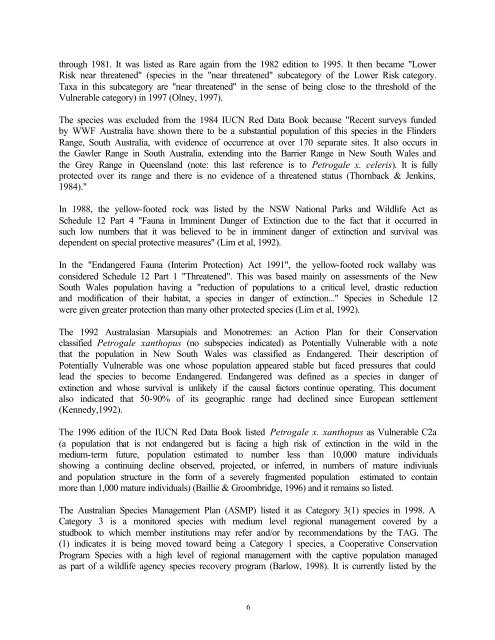Yellow-footed Rock Wallaby Husbandry Manual - Marsupial and ...
Yellow-footed Rock Wallaby Husbandry Manual - Marsupial and ...
Yellow-footed Rock Wallaby Husbandry Manual - Marsupial and ...
You also want an ePaper? Increase the reach of your titles
YUMPU automatically turns print PDFs into web optimized ePapers that Google loves.
through 1981. It was listed as Rare again from the 1982 edition to 1995. It then became "Lower<br />
Risk near threatened" (species in the "near threatened" subcategory of the Lower Risk category.<br />
Taxa in this subcategory are "near threatened" in the sense of being close to the threshold of the<br />
Vulnerable category) in 1997 (Olney, 1997).<br />
The species was excluded from the 1984 IUCN Red Data Book because "Recent surveys funded<br />
by WWF Australia have shown there to be a substantial population of this species in the Flinders<br />
Range, South Australia, with evidence of occurrence at over 170 separate sites. It also occurs in<br />
the Gawler Range in South Australia, extending into the Barrier Range in New South Wales <strong>and</strong><br />
the Grey Range in Queensl<strong>and</strong> (note: this last reference is to Petrogale x. celeris). It is fully<br />
protected over its range <strong>and</strong> there is no evidence of a threatened status (Thornback & Jenkins,<br />
1984)."<br />
In 1988, the yellow-<strong>footed</strong> rock was listed by the NSW National Parks <strong>and</strong> Wildlife Act as<br />
Schedule 12 Part 4 "Fauna in Imminent Danger of Extinction due to the fact that it occurred in<br />
such low numbers that it was believed to be in imminent danger of extinction <strong>and</strong> survival was<br />
dependent on special protective measures" (Lim et al, 1992).<br />
In the "Endangered Fauna (Interim Protection) Act 1991", the yellow-<strong>footed</strong> rock wallaby was<br />
considered Schedule 12 Part 1 "Threatened". This was based mainly on assessments of the New<br />
South Wales population having a "reduction of populations to a critical level, drastic reduction<br />
<strong>and</strong> modification of their habitat, a species in danger of extinction..." Species in Schedule 12<br />
were given greater protection than many other protected species (Lim et al, 1992).<br />
The 1992 Australasian <strong>Marsupial</strong>s <strong>and</strong> Monotremes: an Action Plan for their Conservation<br />
classified Petrogale xanthopus (no subspecies indicated) as Potentially Vulnerable with a note<br />
that the population in New South Wales was classified as Endangered. Their description of<br />
Potentially Vulnerable was one whose population appeared stable but faced pressures that could<br />
lead the species to become Endangered. Endangered was defined as a species in danger of<br />
extinction <strong>and</strong> whose survival is unlikely if the causal factors continue operating. This document<br />
also indicated that 50-90% of its geographic range had declined since European settlement<br />
(Kennedy,1992).<br />
The 1996 edition of the IUCN Red Data Book listed Petrogale x. xanthopus as Vulnerable C2a<br />
(a population that is not endangered but is facing a high risk of extinction in the wild in the<br />
medium-term future, population estimated to number less than 10,000 mature individuals<br />
showing a continuing decline observed, projected, or inferred, in numbers of mature indiviuals<br />
<strong>and</strong> population structure in the form of a severely fragmented population estimated to contain<br />
more than 1,000 mature individuals) (Baillie & Groombridge, 1996) <strong>and</strong> it remains so listed.<br />
The Australian Species Management Plan (ASMP) listed it as Category 3(1) species in 1998. A<br />
Category 3 is a monitored species with medium level regional management covered by a<br />
studbook to which member institutions may refer <strong>and</strong>/or by recommendations by the TAG. The<br />
(1) indicates it is being moved toward being a Category 1 species, a Cooperative Conservation<br />
Program Species with a high level of regional management with the captive population managed<br />
as part of a wildlife agency species recovery program (Barlow, 1998). It is currently listed by the<br />
6




